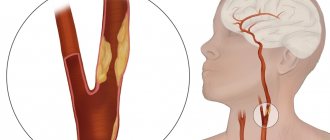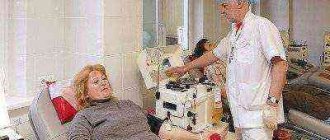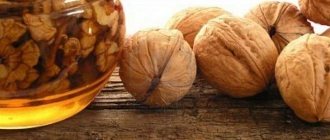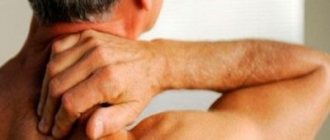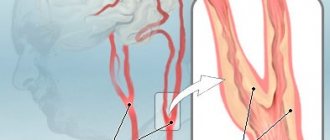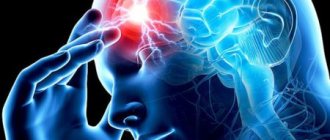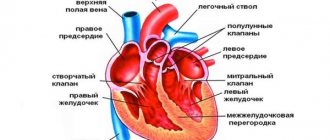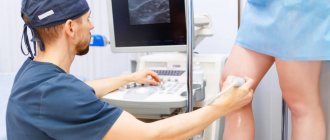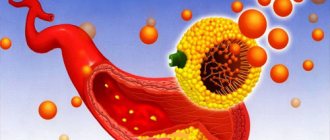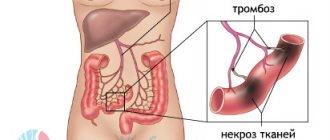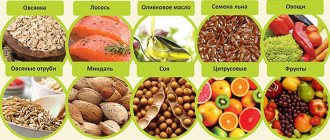Cholesterol plaques are cholesterol tumors that grow on the inner lining of the arteries and, without treatment, lead to serious complications that can cause death.
The most common form of complications of cholesterol plaque on the arteries is the systemic pathology of atherosclerosis.
Today, the pathology of atherosclerosis is diagnosed in every second patient who is over 50 years old.
Cholesterol plaques cause the following pathologies:
- Ischemic heart disease;
- Angina pectoris and cardiac arrhythmias;
- Myocardial infarction;
- Ischemic type cerebral stroke;
- Thromboembolism.
Types of atherosclerotic plaques
It is believed that the severity of symptoms of atherosclerosis depends on the duration of the disease and the presence of complicated plaques.
- Stable. They consist of a large amount of collagen and are not prone to rupture. They are distinguished by their consistency and slow growth.
- Unstable. The formations are rich in lipids and are prone to rupture, which leads to the formation of a blood clot that completely or partially blocks the vessel.
- Heterogeneous. They are considered a dangerous complication of long-term atherosclerosis. They differ from the two previous types by uneven contours, heterogeneous structure, ulcerate, and bleed. This increases the risk of acute thrombosis with embolus formation.
Rupture of a cholesterol plaque occurs without any symptoms. Then everything depends on the speed of formation of the blood clot and its location. If a blood clot clogs a heart vessel, a heart attack will occur, or a stroke will occur in the brain.
In most cases, vascular deformations caused by atherosclerosis are irreversible. You can get rid of cholesterol plaques only at the initial stage of the disease, when they just begin to be deposited on the arterial walls, forming growths.
Stages of education
Pathology develops gradually, passing through several stages. First, the disease is triggered under the influence of causative factors, then the resulting pathological changes lead to an immune response, which strives to protect the body, but creates optimal conditions for the formation of cholesterol deposits.
Stages of atherosclerotic plaque formation:
- A yellow spot forms on the wall of the vessel, consisting of deposits of cholesterol and its compounds,
- The immune system is activated - protective blood cells - T-lymphocytes and monocytes - are concentrated along the periphery,
- The cells die and become part of the nucleus, the destruction of the vascular wall begins,
- Platelets are drawn to the affected area - this is the body’s protective reaction to damage,
- Enzymes that destroy the vascular wall are released into the bloodstream - this leads to active cell division in the affected area,
- The sediment grows and increases in size, collagen and elastin accumulate along the periphery. In this structure you can see the central part - the core and the outer shell - the tire,
- The atherosclerotic plaque thickens, creating an obstacle to blood flow, and the first signs of the disease develop.
At the final stage, the artery loses its elasticity. In advanced stages, damage to the outer shell occurs, ulcers and bleeding form, calcium salts are deposited in the tire, and its elasticity decreases.
Expert opinion!
Patients often ask whether atherosclerotic plaques resolve or not - much depends on the stage of the disease. The optimal time for conservative therapy is in the initial stages, since young clots respond well to treatment. At the calcification stage, it is almost impossible to dissolve atherosclerotic plaques.
Complications caused by atherosclerosis
With deformation, blockage of blood vessels, and disruption of the blood supply to tissues, the following most often develop:
- Trophic ulcers of the feet and legs. When blood flow is impaired, local immunity decreases, the skin loses its ability to regenerate, and inflammatory processes begin. They are difficult to treat and have a long course. Chronic inflammation causes tissue necrosis. Open wounds appear on the skin, prone to constant relapses.
- Gangrene of the legs. Blockage of arteries with plaques, vasospasm during atherosclerosis often causes cessation of blood circulation in the arteries of the lower extremities. Next, tissue necrosis occurs with a change in color from dark brown to black. Consequences: limb amputation.
- Myocardial infarction. Ischemic necrosis of the heart muscle, 98% of cases occurs due to damage to the aorta by plaques.
- Stroke. When the cerebral arteries in the brain become narrowed or blocked, blood flow decreases. An acute vascular accident causes irreversible tissue changes, as a result of which serious neurological disorders develop. Consequences: disability, death.
- Organ ischemia. Cholesterol plaques can damage any vessel and reduce blood flow. The result of insufficient blood supply is temporary failure of functions or permanent damage to organs: intestines, kidneys, lungs, liver.
Atherosclerotic plaques can form in different arteries at the same time. But most often the large vessels of the heart and brain are affected.
Physical activity
Regular physical activity improves blood supply to muscles and internal organs, saturates them with oxygen, and gives strength to restore the body's reserves.
Walking is especially good for those who suffer from atherosclerosis of the arteries of the lower extremities, which manifests itself in the form of pain in the calf muscles when walking - “intermittent claudication.” While walking, not only does blood flow in the leg muscles improve, but also vascular anastomoses are formed, that is, vessels that bypass arteries affected by atherosclerosis. Unfortunately, if you don’t walk every day, then these anastomoses die off (atrophy) as unnecessary.
Modern European and American doctors recommend spending 300 minutes a week on physical activity. It's only 40-50 minutes a day. The figure seems scary only at first glance.
- Make it a rule to get off one stop earlier and walk the remaining distance to home (it’s better if you don’t have heavy bags of groceries in your hands, so as not to overload your joints).
- These are 1-2 10-minute walks with the dog, when you walk with him, and not just stand still, waiting for this electric broom to come running.
- This is cleaning the apartment.
- This is dancing to pleasant music while cooking.
- This is going down the stairs in the subway. It’s better to lift, of course, but it all depends on the condition of your knee joints. If the entire climb is difficult to manage at once, walk at least a few steps, increasing the number of steps by one every day or two.
- This is 10-15 minutes of exercise in the morning.
- Or maybe it’s a full-fledged workout (swimming, aerobics, exercise bike, elliptical trainer, stepper, dancing, etc.).
Let your body feel how it likes to move. And you yourself will not notice how you will get involved, how pleasant it will be for you to feel the movement of blood in your hot limbs, how light your soul will be, and how proud you will feel for yourself.
A pleasant bonus to a healthy diet and physical activity will be weight loss, which will also have a positive effect on the condition of the heart, blood vessels and metabolism.
Causes
Several years ago, high cholesterol was considered the main cause of atherosclerosis. However, studies have shown that the impetus for the deposition of fatty particles on the vascular walls can be:
- Lipoprotein infiltration. Lipoproteins penetrate the vessel wall, accumulate inside, destroying it. This is the initial stage of the formation of cholesterol growths. They do not yet protrude above the inner surface of the artery and appear as flat spots. The changes are reversible.
- Endothelial dysfunction. When the cells lining the inner layer of blood vessels are damaged, they become dense and hard. This slows down blood circulation, creating favorable conditions for low-density lipoproteins to settle on the walls of the arteries.
- Autoimmune factor. Dead and living endothelial cells are perceived as harmful agents and are destroyed. The area of internal damage to the arterial wall quickly increases, and inflammation develops. The affected areas are “patched” with blood clots, low or very low density lipoproteins, which leads to the formation of cholesterol plaques and narrowing of the arteries.
- Exposure to viruses (herpes, cytomegalovirus). Pathogenic organisms cause endothelial damage. Elasticity decreases, vascular permeability increases. Their walls become loose. Cholesterol begins to settle in areas of damage.
- Antioxidant system disorders. Excess free radicals damage the vascular walls, where plaques then begin to form. Only antioxidants can resist this. With their deficiency, the unhindered development of atherosclerosis begins.
- Hereditary factor. A genetic defect in the venous or arterial walls, metabolic disorders cause vascular inflammation and increased cholesterol production.
- Hormonal factor. With age, the concentration of gonadotropic and adrenocorticotropic hormones may increase, which causes increased production of cholesterol, which is their main building material.
A number of key factors, overlapping each other, can significantly accelerate the development of atherosclerosis and cause irreversible vascular changes.
Secondary reasons that create favorable conditions for the formation of atherosclerotic plaques are:
- Hypertonic disease. It is characterized by a persistent increase in blood pressure and increased stress on the heart. With this disease, the risk of vascular lesions increases by 40%.
- Physical inactivity. With low mobility, the force of muscle contraction decreases, circulatory functions are disrupted, and the speed of blood flow decreases. These factors create favorable conditions for the sedimentation of cholesterol particles and the formation of blood clots.
- Smoking. Nicotine and tar, entering the blood, cause vasospasm. Over time, their elasticity decreases, endothelial cells are damaged, and plaques begin to accumulate.
- Alcohol. Causes pathological expansion and then a sharp narrowing of blood vessels, which negatively affects blood circulation. This process is very dangerous for the arteries. They become damaged, become more permeable and fragile. Dyslipidemia appears. All this leads to the deposition of fatty plaques.
- Unstable psycho-emotional state. Frequent stress negatively affects the condition of the heart muscle. When under emotional stress, adrenaline is produced, blood pressure rises, and the load on the heart increases. The blood becomes viscous, thick, and the blood flow rate decreases, which contributes to the formation of plaques and blood clots.
- Poor nutrition. The predominance of animal fats, trans fats, and fast food disrupts lipid metabolism. The liver does not have time to process excess fat-like particles.
- Diabetes. The disease is accompanied by chronic inflammation of the arteries, which is the main cause of endothelial damage.
Formation of cholesterol plaque in the arteries
Plaques in the main vessels are formed with the help of cholesterol, which is produced in the body by liver cells and enters it with food.
Cholesterol is divided into:
- Good is high molecular density lipoprotein (HDL);
- The bad ones are low and very low molecular density lipoproteins (LDL and VLDL).
HDL molecules take part in many metabolic processes in the body, and high-density cholesterol cleanses the bloodstream of free lipid molecules and transports them to liver cells for disposal by bile acids.
Plaque formation occurs gradually.
LDL and HDL molecules transport cholesterol, as well as triglycerides, into every cell of the body to form and strengthen the cell membrane.
The structure of the molecules of low-density lipoproteins has a viscous consistency, which gives it the ability to stick to the vessels, on the inside, forming a cholesterol plaque.
The main arteries are the place where plaque formation occurs.
Most often cholesterol plaques settle:
- On the vessels of the neck;
- On the coronary vessels;
- On the aorta;
- On the vessels supplying blood to the lower extremities.
Plaque formation occurs gradually, first involving several molecules of low-density lipoproteins that form a lipid stain. LDL molecules begin to stick to the lipid patch, and the fatty plaques increase in size.
At this stage, the solubility of cholesterol reaches 95.0%, and if you start therapy to dissolve cholesterol in the vessel, you can completely clean the area where the fatty stain has adhered.
After the plaque has formed from lipid molecules, then calcium ions join them, which makes it dense and hard in consistency, capable of blocking the arterial lumen.
The pathology of atherosclerosis develops, which is one of the main consequences of a high index in human blood.
After the plaque has formed from lipid molecules, then calcium ions join them, which makes it dense and hard in consistency.
Symptoms
The first atherosclerotic changes in blood vessels do not manifest any characteristic external signs. Narrowing of the arterial lumen due to the accumulation of cholesterol particles is a slow process that lasts for years.
General clinical signs of atherosclerosis:
- general weakness even with minor physical exertion;
- sudden numbness of the fingers or toes, a feeling of “pins and needles”;
- deterioration of speech and vision.
In case of chronic damage to the arteries, the symptoms will depend on the location of the damaged areas and cholesterol growths:
- Thoracic aorta. Pulling or sharp short-term pain in the heart appears, which radiates to the cervical spine, shoulder blade, and left arm. Blood pressure periodically rises, shortness of breath appears. In the acute course of the disease, small-focal myocardial damage (microinfarction) is possible.
- Neck and head. If cholesterol plaques affect the paravertebral, subclavian or carotid arteries, mental disorders most often occur. Patients' memory, speech, and hearing deteriorate. Sudden changes in mood, aggression, dementia, and mini-stroke may occur.
- Lower limbs. More often the process manifests itself as muscle pain that occurs even after a short walk. As the disease progresses, lameness appears and trophic ulcers appear on the skin of the legs.
- Abdominal section. Atherosclerotic lesions of the intestinal vessels are accompanied by dyspeptic disorders: stomach pain, upset stool, and increased gas formation. When the arteries of the kidneys are damaged, problems with urination appear: pain, frequent urge to urinate.
Manifestations that can be noticed:
- Xanthomas. Convex, dense growths from white to yellow. Appear on the fingers and toes, in the area of the Achilles ligament.
- Xanthelasmas. Flat spots of yellow color. Appear on the skin of the eyelids in single plaques or groups.
- In rare cases, cholesterol deposits may appear as an arc of grayish-white color along the edge of the iris.
The appearance of external signs of high cholesterol in adolescents or young adults indicates a genetic form of the disease.
Conditionally permitted types of food
Some foods with atherosclerosis are allowed to be eaten in limited quantities. They are not prohibited, but you should not abuse them. They should be included in the diet occasionally so that the patient does not feel hungry. These types of food include:
- Seafood. The patient can eat mussels, squid or seaweed in small quantities. This will enrich the body with iodine.
- Eggs. Proteins can be eaten every day and do not contain harmful lipids. As for yolks, they are included in the diet no more than 2-3 times a week.
- Fatty sea fish. This type of food is recommended for aortic damage. If the patient has cerebral atherosclerosis, then this product is excluded from the menu.
- Rye bread products. They can be eaten very moderately.
- Drink made from chicory. Patients with atherosclerosis are strictly prohibited from drinking coffee. This drink increases blood pressure and negatively affects blood vessels. If the patient is accustomed to the coffee taste, then a chicory surrogate can be used.
- Cheeses. This product can be eaten in very small quantities. In this case, you need to choose mild varieties.
- Fruits. Patients with atherosclerosis should not eat sweets: chocolate, ice cream, cakes. Therefore, many patients do not have enough sugar. To compensate for this deficiency, a small amount of sweet fruits and dried fruits are introduced into the diet: bananas, pears, prunes, dried apricots.
- Greenery. Parsley and dill are useful for atherosclerosis, but spinach, sorrel and raw onions should be avoided. Garlic is generally not recommended. However, for atherosclerosis, doctors advise using garlic tincture in moderate doses. This is a folk remedy for plaques in blood vessels.
Many patients are interested in: is it possible to eat potatoes with atherosclerosis? For vascular diseases, doctors usually recommend eating vegetables. But you need to remember that potatoes are quite high-calorie foods. Therefore, you need to eat it in moderation, since it is undesirable for a patient with atherosclerosis to gain weight. Potatoes are prepared boiled or baked. You should not fry this vegetable, such food is harmful. It is very useful to drink potato juice; it is a good folk remedy for the treatment of atherosclerosis.
Diagnostics
An accurate diagnosis can only be established by a doctor after a comprehensive examination:
- Examination, recording of patient complaints. During the conversation, the doctor finds out the possible causes of the disease: living conditions, bad habits, nutrition, heredity.
- Blood chemistry. It is carried out to detect dyslipidemia.
- Lipidogram. Prescribed for elevated total cholesterol levels. The study helps to identify the relationship between different fractions of lipoproteins.
- X-ray. Conducted to examine the coronary arteries, identify cholesterol growths or possible complications: calcification, aneurysm.
- Angiography. A contrast agent is injected into the patient’s blood, which helps identify stenosis, a narrowing of the lumen of blood vessels.
- Ultrasound. Prescribed for acute atherosclerosis to assess the performance of internal organs.
Considering that atherosclerosis most often develops against the background of high cholesterol, it is recommended to donate blood every 5 years. For problems with the cardiovascular system, diabetes – once/1-2 years.
Reducing inflammation
Arterial pressure
In order to reduce inflammation and damage to the vascular wall, it is necessary first to normalize blood pressure.
In people suffering from hypertension, the mechanism for maintaining blood pressure is “knocked down.” “Pressor” factors begin to predominate in the body, that is, factors that contribute to vasospasm and increased blood pressure. And “depressor” factors, that is, factors that promote relaxation of the vascular wall, begin to “lose ground.” This leads to the fact that the vessels are constantly in a “tense”, narrowed state. This disrupts the blood flow inside the arteries that supply blood to the arteries (yes, imagine, we have such miracles =)), thus leading to ischemia of the vascular wall, and then to the deposition of bad cholesterol in it. This, in turn, leads to an even greater narrowing of the lumen of the arteries and an even greater increase in pressure. This is such a vicious circle.
In order to break it, it is necessary to take drugs that normalize blood pressure. Many of them also have pleasant “side effects”, such as improving the condition of the heart, kidneys, and blood vessels of the brain. All you need is to consult a doctor in time, who will prescribe the treatment that is right for you.
Currently, the norm for blood pressure is a pressure not exceeding 140/85 mmHg.
It only takes a couple of minutes to measure your blood pressure, but knowing your blood pressure numbers and promptly seeing a doctor can significantly prolong your life.
If you do not have a blood pressure monitor at home, now in any city clinic you can quickly undergo a basic examination (blood pressure, blood sugar, cholesterol, measure height and weight) in health rooms or pre-medical examination rooms.
Smoking
Smoking is a universal damaging factor.
Smoking causes peripheral vasospasm, thereby reducing blood supply to tissues and organs. This is especially true for the condition of the legs - leg amputations associated with impaired circulation in the arteries of the lower extremities - frequent companions of heavy smokers.
Smoking causes arterial spasm to increase blood pressure.
Smoking causes hypoxia (lack of oxygen) and increases the level of inflammation in the body, thereby increasing the manifestations and rate of development of atherosclerosis.
Smoking is a conscious choice for everyone. I cannot brainwash myself on the topic of quitting smoking, because I know that until you personally are affected by the problems associated with constant smoking, it is pointless to say anything. So just watch your body. Do your nails turn blue after another cigarette, do you have a cough in the morning, are your feet a normal color, do your calves and shins hurt when you walk. If any of these symptoms bother you, this is a reason to consult a doctor, if not for help in quitting smoking, then at least to diagnose complications associated with it.
Increased blood sugar
Elevated blood sugar is another factor that increases inflammation in the body. If you suffer from diabetes, the risk of atherosclerosis and cardiovascular complications increases by 20-30%, depending on your blood sugar level.
When sugar rises above normal (above 6.1 in blood from a finger and above 7.0 in blood from a vein), proteins in the body begin to glycate. In other words, “candied”. The vascular wall also suffers.
If you suffer from diabetes and have certain complications, the target blood sugar level for you, depending on your age and health status, will be set by your attending physician.
Long-term maintenance of target blood sugar levels will allow you to live a long and fulfilling life without suffering from the complications of diabetes.
How to get rid of atherosclerotic plaques?
With a significant narrowing of the lumen of the artery, the patient’s condition is complicated by persistent circulatory disorders. This requires the use of more serious methods of therapy - surgical or drug intervention.
Conservative therapy is aimed at eliminating risk factors that create favorable conditions for the formation of cholesterol growths. This includes:
- quitting smoking, alcohol;
- increased physical activity;
- stabilization of psycho-emotional state;
- normalization of body weight.
Adjusting your lifestyle begins with proper rest, healthy sleep, at least eight hours. Physical activity should be increased gradually. You can start with short walks, swimming, or simple warm-up in the morning. Gradually, you can increase the load: jogging, cycling, swimming, fitness.
Nutritional Features
How to dissolve cholesterol plaques with diet? How effective is it?
The diet does not imply fasting or severe dietary restrictions. You need to avoid foods containing large amounts of fat, carcinogens, and food additives.
Can be used:
- vegetables, herbs, fruits;
- soybeans, cereals, legumes;
- low-fat varieties of sea fish;
- nuts without salt/sugar;
- olive or vegetable unrefined oil;
- egg white;
- dairy/fermented milk products with a fat content of no more than 5%;
- whole grain or bran bread;
- fruit desserts;
- berry smoothies, green or ginger tea, compotes, fruit drinks.
It is recommended to completely avoid sugar and replace it with honey. Salt intake is also reduced - no more than 5 g/day.
While following a diet, we must not forget about the balance of proteins, fats, carbohydrates, so 2-3 times a week we must eat:
- dietary poultry, lean veal or beef;
- river fish;
- cheeses fat content no more than 20%;
- dried fruits;
- crabs, oysters, shrimp;
- egg yolk;
- dried white bread;
- pasta;
- real red wine, jelly.
These products contain low amounts of cholesterol. This replenishes the body’s daily need for protein and carbohydrates and does not cause an increase in the concentration of bad cholesterol.
Foods containing large amounts of cholesterol should be completely excluded from the diet:
- offal;
- caviar;
- fatty meat: pork, lamb;
- fish, meat semi-finished products;
- canned food;
- fast food;
- baked goods, sweets;
- confectionery;
- full-fat homemade milk, cheeses, sour cream, cream;
- alcoholic/carbonated drinks.
Fried, pickled, smoked foods are completely excluded. Products are boiled, steamed, baked. This allows you to save more vitamins and avoid consuming dangerous carcinogens. A healthy diet helps get rid of cholesterol deposits within three months.
Medications
They reduce high cholesterol, slow down the process of plaque formation, and increase life expectancy in people who have had a heart attack, stroke, or suffer from coronary artery disease.
The basis of treatment is lipid-lowering drugs; in addition to them, agents are prescribed that restore the properties of blood vessels, accelerate tissue regeneration, and normalize metabolism:
- Statins: Simvastatin, Lovastatin, Fluvastatin, Atorvastatin, Rosuvastatin. They act on liver cells, inhibit the enzyme that is responsible for the synthesis of cholesterol, and reduce the amount of LDL.
- Fibrates: Clofibrate, Gemfibrozil, Fenofibrate. Reduces the production of triglycerides and low-density lipoproteins. They are not able to dissolve cholesterol particles or formed growths. Medicines slow down their growth and prevent the formation of new lesions.
- Nicotinic acid: Niacin, vitamin PP. It has a beneficial effect on the condition of blood vessels: strengthens arterial walls, relieves inflammation, removes excess LDL, and increases the amount of HDL.
- Ezetimibe. A new drug that prevents the formation of cholesterol plaques. The principle of action is to reduce the absorption of this substance by the small intestine.
- Bile acid sequestrants: Cholestyramine, Colestipol. Increases the excretion of bile acids. Their insufficient intake forces the liver to compensate for the loss of low-density lipoprotein reserves. This lowers the level of dangerous cholesterol.
There is no universal drug treatment regimen; everything is individual.
Effective methods to remove plaques
Radical methods are rarely used when blockage of a vessel with cholesterol plaques directly threatens the patient’s life. The surgeon restores the lumen of the artery using various methods:
- Stenting. A thin metal tube (stent) is inserted into the vessel damaged by plaques. It expands the narrowed area, improving blood supply.
- Coronary bypass surgery. The thoracic, radial artery or part of a large vein of the lower limb is used as a shunt. A bypass path for blood is formed from it, due to this the blood supply to the organ is completely restored.
- Endarterectomy. The surgeon cuts the artery and removes the cholesterol plaque from it. Then plastic surgery of the vascular wall is performed using a synthetic patch and it is sutured.
- Angioplasty. Vessels affected by cholesterol deposits are dilated with a catheter with a small reservoir at the end. The device is inserted into the artery and the balloon is inflated. When straightened, it destroys plaques and restores the lumen.
After surgery, a long recovery period and careful monitoring of the patient's health condition are required.
Treatment methods
The fight against cholesterol plaques should be comprehensive and include several areas of treatment:
- Lifestyle change;
- Diet food;
- Non-drug therapy;
- Drug therapy - treat with drugs that dissolve lipid tumors in the blood.
You can remove bad cholesterol from blood vessels in humans using non-drug methods:
- Get rid of bad habits - alcohol and smoking;
- Change a sedentary lifestyle to exercise;
- Introduce daily stress on the body;
- Avoid stressful situations and overstrain of the nervous system.
How to dissolve using drugs?
In order for cholesterol plaques to dissolve, the doctor prescribes a course of medications. A medicine that can reduce lipid formations should not cause negative reactions in the body.
Lipid plaques are resolved when treating pathology with drugs of the pharmacological group statins (the drug Crestor, the drug Rosuvastatin and Rosucard).
Statins are not used as self-medication because they have a long list of contraindications and side effects.
Only the attending physician can select a drug for resorption with minimal negative effects on the body.
Popular statins
Also, cholesterol plaques can be resolved by taking the following groups of medications:
- Fibrates group - lowering the triglyceride index in the blood. The drug Fenofibrate is used;
- Vitamins (vitamins A, B, C) and mineral complexes;
- Bioadditives with Omega-3;
- Bile sequestrant preparations promote the resorption of cholesterol plaques.
Operative method
Removal of cholesterol plaques in blood vessels is carried out using the following surgical treatment methods:
- Minimally invasive stenting method . This technique allows you to expand the arterial lumen using a stand inserted into the site of the artery lesion. Using the stand, lipid deposits are removed, and the blood is necessarily filtered to avoid the development of thrombosis;
- Shunt installation method . On the carotid arteries, bypass surgery is performed using a puncture in the neck. The integrity of the vessels during this operation is not compromised;
- The carotid endarterectomy method is an open type of operation that is performed at the site of a cholesterol plaque. The vessel is cut, atherosclerotic deposits are removed, and the removal site is sutured.
Carotid artery stenting
Diet
With an increased cholesterol index, which contributes to the growth of lipid tumors on blood vessels, it is necessary to use an anti-cholesterol diet in treatment.
The diet can not only lower cholesterol, but also restore lipid metabolism, which will help the resorption of plaques.
When dieting, it is necessary to exclude from the menu such foods that increase the concentration of lipids in the blood and contribute to the deposition of excess lipid molecules on the inner lining of blood vessels:
- Animal fats, butter, margarine and all trans fats, lard;
- Fatty meats and meat by-products;
- Strong coffee;
- Sugar and sweets;
- Eggs;
- Smoked products;
- Sausages;
- Confectionery products;
- Dairy products with high fat content;
- Canned meat and fish;
- Semi-finished meat and confectionery products, industrial production.
To use in the diet, you need foods that are rich in fiber, vitamins and polyunsaturated fatty acids, which dissolve lipid plaques in the arterial membranes:
- Teas (herbal and green) and decoctions (rose hips and chamomile flowers);
- Sea fish, as well as Omega-3 dietary supplements;
- Sea cabbage contains a large amount of iodine molecules, which helps improve the functioning of the thyroid gland and will help resolve lipids in the membranes;
- Fresh and heat-treated vegetables - carrots, all varieties of cabbage, eggplants, cucumbers and tomatoes;
- Legumes - peas, beans, soybeans, lentils and black beans;
- Fresh fruits - apples, plums, apricots;
- Citrus;
- Nuts;
- Egg whites;
- Onions, garlic and garden herbs;
- Cereals;
- Garden and forest berries;
- Low-fat fermented milk products;
- Lean (white) meats - turkey meat, rabbit and chicken meat, young veal;
- Rye or bran bread;
- Vegetable oils - olive, flaxseed, sesame;
- Products with vitamin C.
The most harmful products
Resorption using traditional methods
You can get rid of lipid tumors in blood vessels using the following methods:
- Light massage if there is no high blood pressure;
- Exercise therapy method;
- Morning exercises;
- Method of hirudotherapy for resorption of lipid deposits in the cervical arteries and in the arteries of the lower extremities. The enzymes secreted by leeches thin the blood and are able to dissolve lipid stains;
- Taking homeopathic medicines in combination with diet;
- The use in treatment of infusions and decoctions of medicinal plants that effectively fight atherosclerotic deposits and prevent new growth on the vascular membranes. The herbs used in therapy are chamomile and calendula, St. John's wort, strawberry and raspberry leaves, linden inflorescences, rose hips and rowan berries, birch buds and lemon balm.
Herbal infusions and decoctions
Folk remedies for atherosclerosis
Traditional methods of cleansing blood vessels from cholesterol are effective in the initial stages of the disease. It is advisable to use traditional methods of treatment in consultation with a doctor as a supplement to the diet.
Properly selected components help reduce the level of dangerous LDL, increase the concentration of HDL, slow down the growth of atherosclerotic plaques, and strengthen blood vessels.
The following recipes are most effective:
- Garlic tincture. It is considered one of the most effective remedies. It eliminates cholesterol plaques, normalizes blood pressure, and prevents the development of cardiovascular diseases and cancer. To prepare it, 200 g of garlic cloves are passed through a meat grinder and 0.5 liters of vodka are poured in. Infuse for 14 days in a cool, dark place. The finished infusion is filtered and taken 20 drops three times a day before meals.
- Honey, lemon juice, olive oil. They help improve immunity and eliminate vascular inflammation. To prepare the mixture, all ingredients are mixed in equal quantities. The medicine is taken in the morning on an empty stomach, 1 tbsp. l.
- Linseed oil. Drink 1 tbsp. l. three times/day. The oil slows down the growth of plaques and strengthens blood vessels.
- Potato juice. Helps clear arteries of cholesterol deposits and lower LDL levels. One medium potato is grated, the juice is squeezed out, and drunk in the morning on an empty stomach.
- A decoction of rose hips and hawthorn. Helps normalize blood pressure, cleanse blood vessels, and restore their elasticity. To prepare the infusion, take 50 g of dry fruits, add 1 liter of water, bring to a boil, and simmer for about 10 minutes. Leave for 8 hours. Drink 1 glass three times a day.
- Onion juice. Finely chop the medium head of onion, add 100 g of liquid honey, leave for 4 hours. During this time, the onion will release a lot of juice, which is taken three times a day, 1 tsp.
- Pumpkin juice. Reduces bad cholesterol, restores elasticity and strength of blood vessels, and prevents the deposition of atherosclerotic plaques. Drink natural juice throughout the day before meals.
- Tincture of meadow clover. Helps with high cholesterol, problems with blood vessels, and relieves insomnia. 40 g of dry raw materials are poured with boiling water, boiled for 5 minutes, and allowed to brew. Take 1 tbsp. l. before bedtime.
Folk remedies should be used with extreme caution after a heart attack or stroke.
Compress in the treatment of atherosclerosis of the legs
Typical atherosclerosis of the legs of varying severity is observed in 25% of women and 30-40% of men for every 1000 people, mainly after 40 years. If you experience pain in your leg when walking, and then at rest, a feeling of numbness in the muscles or compression, cramps, the limb becomes pale and cold - there is a high probability that you have atherosclerosis of the legs.
Treatment with folk remedies includes an integrated approach. You should adjust your diet, eliminate fried, spicy, smoked foods if possible, stop smoking, and increase physical activity.
To restore arteries, it is useful to make applications with herbal infusions. Mix equal proportions of plantain, chamomile, string, sage, St. John's wort. Pour a spoonful of the resulting mixture into one glass of boiling water and leave. A gauze soaked in the infusion should be placed on a leg washed with laundry soap, wrapping the limb from the groin to the heel, and wrapped with compress paper and a sheet on top. A similar procedure should be carried out 2 times a day for 4 or at least 3 hours. The course of treatment is up to 3 weeks.
Surgical and hardware removal
Cholesterol plaques on the face are also removed through surgery if medications and folk remedies do not help obtain the desired therapeutic effect.
The following indications exist:
- cosmetic defect;
- spread of xanthomas throughout the body (there is a high probability of their damage, against which pain appears and an inflammatory process develops);
- patient's wishes.
Surgical treatment is carried out using the following methods:
Cholesterol plaques on the face and eyelids are best removed with laser
| Name | Advantages | Flaws |
| Cryodestruction |
|
|
| Surgical removal | Cholesterol plaques are completely removed. The surgeon makes a small incision in the area of the xanthoma. Separates it from adipose tissue and blood vessels. After this, the wound is sutured with special threads. The doctor performs surgical treatment for large formations, if it is impossible to carry out laser therapy or cryodestruction. |
|
| Laser therapy |
|
|
| Radio frequency exposure |
|
|
After surgery, the fatty growths around the formations are resolved, and cholesterol is eliminated through the blood naturally.
Herbs and fees
A whole arsenal of mixtures, extracts, extracts, herbal teas is used in medicine - this is an indicator of their beneficial effect.
Altai tea
It has a comprehensive effect on the cardiovascular system, reduces the risk of stroke and heart attack. In order to improve food absorption and normalize cholesterol levels, it is better to use it with lemon.
Clover
Infusions and teas with clover have a healing effect. Especially recommended for hypertension.
horse chestnut
The flowers of the plant and the prickly skins of the fruit are used. With its excellent effect on blood vessels, chestnut can slightly increase blood pressure.
Pine cones
Green young cones, rich in resins and essential oils, are collected.
Carnation
For the amateur, the product has a very positive effect on blood vessels, increasing their elasticity. Drinking drinks with it improves immunity.
Flax seeds
Good for digestion, but proper absorption of foods guarantees a low risk of vasoconstriction.
